Stephen Mohan set up Mohan Agri near Robinstown in Co Meath in 2006. Having previously studied agricultural engineering for a period, he decided contracting was something he wanted to pursue.
The first step was to buy his first tractor, a new John Deere 6920S, a substantial investment for any 19-year-old. Since then, Stephen has worked hard to build the business to what it is today.
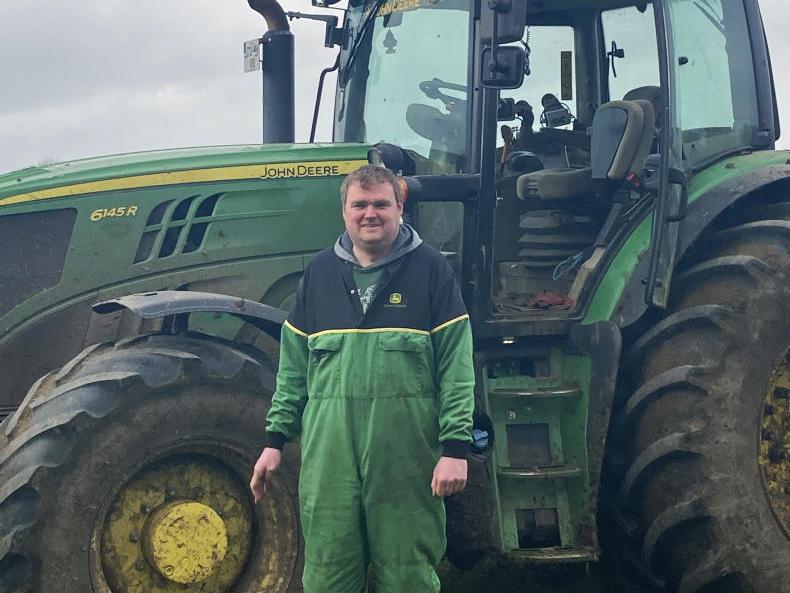
Stephen Mohan, Robinstown, Co Meath.
Keeping things streamlined, he focuses entirely on silage cutting, slurry/dung spreading, and planting and harvesting maize.
Getting started
Stephen started out subbing himself and his tractor in to a local tillage farmer, which he still does at certain times of the year, usually for spring ploughing or the likes. He says this suits as slurry has eased off and it’s before the silage rush starts.
On the silage front, he started out with two Pöttinger wagons. With the business growing and three wet seasons in the run-up to 2010, he made the move to a self-propelled harvester, a secondhand John Deere 7400.
“In the years that followed, the business really began expanding due to the abolition of dairy quotas. It’s not that we gained many new customers, but that our existing dairy customers nearly all expanded. This was a real benefit to the business.”
When it comes to machinery and contracting, backup is key, Stephen says, and he hasn’t once moved away from John Deere since the start.
“Dealer backup and service is vital. It’s like insurance knowing that a dealer is no more than 10 minutes down the road and that there will always be a backup machine on the street in minutes, regardless if it’s a tractor or a forager. With the way the seasons have gone and the price of machinery, it’s important.
“There are plenty of contractors about. It’s a matter of running a good business, providing a good reliable service and being there when you say you’ll be there.”
Silage
Stephen’s current fleet consists of a John Deere 8400i self-propelled harvester and a mix of Smyth and Broughan trailers ranging between 22ft and 24ft.
“The John Deere foragers have served us well over the years. The only one that was a little disappointing was the last 8500i, which we traded a season later for an 8400i. Although it had slightly less power on paper, it was a much better machine to lift grass. The first 8500i I bought was an ex-demo, so it happened to be fitted with the harvest lab package. It’s something I’ve transferred to the machines that followed.
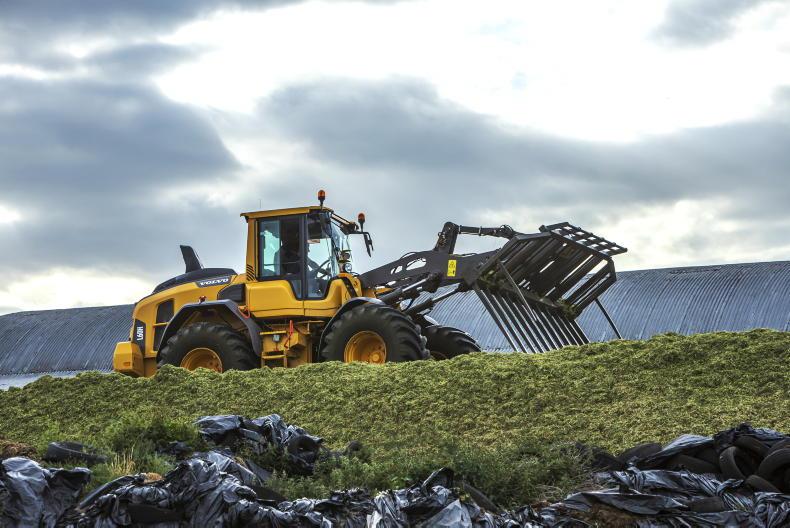
This year Stephen plans to upgrade his L60H Volvo for a larger machine. \ Adrian Leech Photography.
“Not all customers look for the crop reports and yield data, but some do, especially the younger generation. It’s something I feel we will see more of in time. It provides the customer with a great insight to the amount of tonnes that came off a particular field and where exactly yielded best.”
Stephen runs a set of John Deere butterfly mowers, a JD R950R rear and an F310R front combination.
“They’re a great mower to mow, maybe a little hard to drive, but Kuhn were always like that. They spend the season on the 6250R, which is more than capable of managing them. I’d say if I’ve spent €600 on the mowers now in their third season that would be all.
“A Big M would be no doubt more manoeuvrable and get through more acres, but the low running cost is a major attraction to the butterflies. This topped off by the fact there’s a capable tractor in the yard that can be used all year round leaves the butterflies as first choice for me.

Stephen's 6250R and John Deere butterflies. \ Adrian Leech Photography.
“When the pressure’s on, we tend to take out the front- and side-mounted combination to give the butterflies a hand.
“A lot more customers are looking for grass to be tedded now, so we have an 12-rotor tedder there and we rake everything with the Krone 1400 four-rotor rake.
“We hope to demo a merger at some point this year to see how it preforms. So far, they don’t seem to be the replacement for a rake in terms of output, but the concept is good.
“Up until now, we’ve been running a Volvo L60H, which we are considering changing for a heavier more capable machine. Moving to a bigger loader gives us the scope to jump to a slightly larger harvester next time around.”
Slurry
In 2015, Stephen bought his first umbilical system, which makes up one of three systems today. Since then, slurry has become as important as silage, accounting for a large proportion of the business that is continuing to grow.
Typically, slurry starts once the ban lifts and keeps busy throughout the summer.
Earlier this spring, Stephen took delivery of two new 5,000-gallon Newrock tri-axle, full-spec tankers mainly for ferrying alongside his 4,000-gallon Redrock to the umbilical systems.
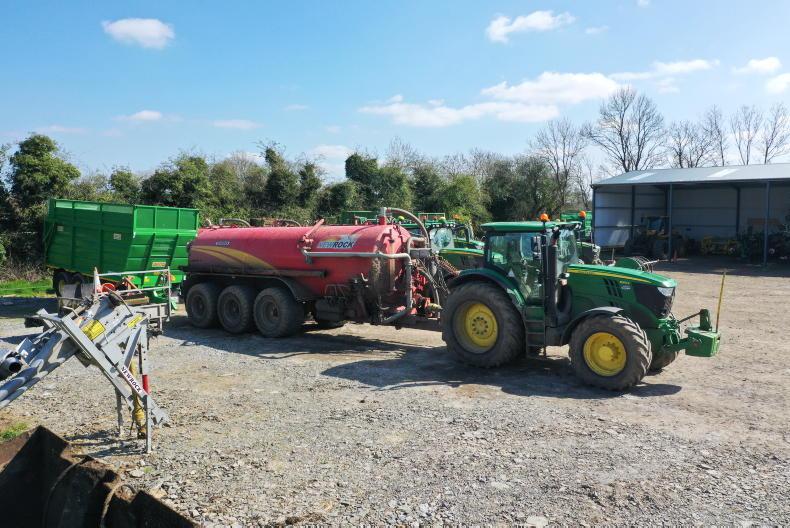
Earlier this year Stephen took delivery of two new Newrock 5,000-gallon slurry tankers, which are mainly used for ferrying slurry to the umbilical systems.
He noted how the tankers were a serious addition to the fleet this spring. “They’re both fitted with DCI arms, hydraulic drive vacuum pumps and Doda L27 pumps, meaning we can pump to either of the umbilical systems from the gap without leaving the cab.”
He noted that there are two 10m Mastek dribble bars on the way for each of the new tankers for field spreading.
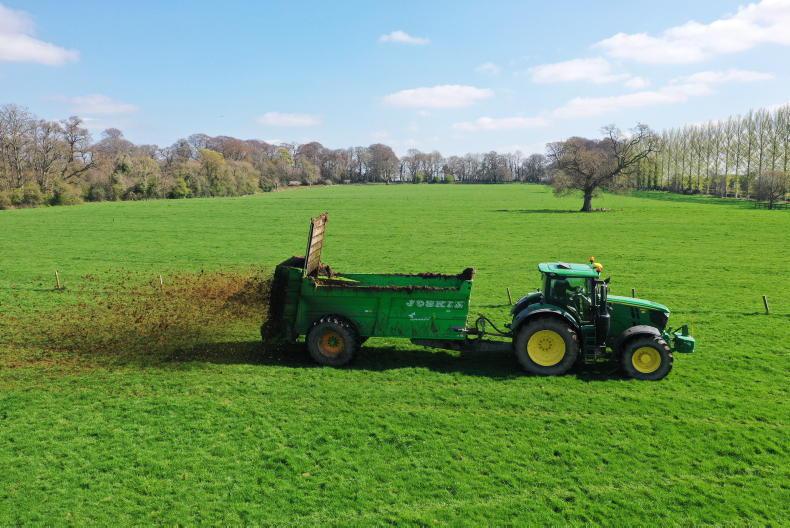
Stephen spreading dung with his Joskin dung spreader and John Deere 6250R.
Tractors
Believe it or not, when it comes to tractors, Stephen has never owned anything else but John Deere.
When asked if he would ever throw a cat among the pigeons and opt for another brand, he says: “The only other brand I would consider for now would be a Fendt, but all the men are happy on the Deeres and I’m happy with the service I’ve got from them all to be honest.
“I’ve had tractors pass through the yard, R series especially, and have cost me nothing more than the price of servicing after 9,000 hours. I’ve been lucky with them.
“The policy here is to change the new tractors once they’re paid for after five years.
“By this stage there could be anywhere up to 9,000 hours on the clock. With the price of gear nowadays, it’s important they are kept working.”
The fleet comprises seven John Deere tractors currently – a 6145R, 6175R, 6175R, 6190R, 6210R, 6250R and a 7530 he bought over the winter for pump duties to save the fresher tractors.
Challenges
Currently, Stephen employs five full-time staff, with an extra one or two drivers coming in at peak season.
“Each driver and customer is set up on one-click accounts. Drivers record each day’s work on the phone app under the customer’s profile. I find this a great management tool, helping keep on top of book work.
“I can pull up a particular customer’s account after a job and let them know what exactly is owed, etc, if the question is asked.
“Into the future, I think labour is going to be a challenge for the sector.
“With the seasons getting so short and the fact there doesn’t seem to be as many young people interested, I see staff eventually becoming an issue unless you can keep full-time staff.
“I am lucky I have a team of good men and do the best I can to keep them in steady work on good gear which is important.
“I also think the rising cost of machinery will become a serious issue.
“For example, I recently priced another 5,000-gallon tanker. The identical tanker to what I bought earlier in the year would cost me another €8,000 today, completely down to rising steels costs.
“Another example is tractors. To buy another 6250R new today, it would cost me at least €15,000 more than what I paid in 2019 for the exact same tractor.
“These are just two examples. I know secondhand tractors are worth more to trade with Brexit, but, still, it doesn’t make up the difference. You would wonder where or if it will all stop.”
Best machine
“The best machine I’ve owned would be the John Deere 6250R. I bought it new in 2019 and have clocked up almost 3,300 hours so far. It’s such a versatile tractor, capable of pretty much any task sent its way and what’s more it hasn’t cost a minute’s bother so far.”
Worst machine
“I’d say the worst machine I’ve owned would have to be an old Quickcut wholecrop header we used to run. It broke our heart every time it left the yard, shearing the bed. But to be fair we traded it for a newer model which as a big improvement.”
Stephen Mohan set up Mohan Agri near Robinstown in Co Meath in 2006. Having previously studied agricultural engineering for a period, he decided contracting was something he wanted to pursue.
The first step was to buy his first tractor, a new John Deere 6920S, a substantial investment for any 19-year-old. Since then, Stephen has worked hard to build the business to what it is today.

Stephen Mohan, Robinstown, Co Meath.
Keeping things streamlined, he focuses entirely on silage cutting, slurry/dung spreading, and planting and harvesting maize.
Getting started
Stephen started out subbing himself and his tractor in to a local tillage farmer, which he still does at certain times of the year, usually for spring ploughing or the likes. He says this suits as slurry has eased off and it’s before the silage rush starts.
On the silage front, he started out with two Pöttinger wagons. With the business growing and three wet seasons in the run-up to 2010, he made the move to a self-propelled harvester, a secondhand John Deere 7400.
“In the years that followed, the business really began expanding due to the abolition of dairy quotas. It’s not that we gained many new customers, but that our existing dairy customers nearly all expanded. This was a real benefit to the business.”
When it comes to machinery and contracting, backup is key, Stephen says, and he hasn’t once moved away from John Deere since the start.
“Dealer backup and service is vital. It’s like insurance knowing that a dealer is no more than 10 minutes down the road and that there will always be a backup machine on the street in minutes, regardless if it’s a tractor or a forager. With the way the seasons have gone and the price of machinery, it’s important.
“There are plenty of contractors about. It’s a matter of running a good business, providing a good reliable service and being there when you say you’ll be there.”
Silage
Stephen’s current fleet consists of a John Deere 8400i self-propelled harvester and a mix of Smyth and Broughan trailers ranging between 22ft and 24ft.
“The John Deere foragers have served us well over the years. The only one that was a little disappointing was the last 8500i, which we traded a season later for an 8400i. Although it had slightly less power on paper, it was a much better machine to lift grass. The first 8500i I bought was an ex-demo, so it happened to be fitted with the harvest lab package. It’s something I’ve transferred to the machines that followed.

This year Stephen plans to upgrade his L60H Volvo for a larger machine. \ Adrian Leech Photography.
“Not all customers look for the crop reports and yield data, but some do, especially the younger generation. It’s something I feel we will see more of in time. It provides the customer with a great insight to the amount of tonnes that came off a particular field and where exactly yielded best.”
Stephen runs a set of John Deere butterfly mowers, a JD R950R rear and an F310R front combination.
“They’re a great mower to mow, maybe a little hard to drive, but Kuhn were always like that. They spend the season on the 6250R, which is more than capable of managing them. I’d say if I’ve spent €600 on the mowers now in their third season that would be all.
“A Big M would be no doubt more manoeuvrable and get through more acres, but the low running cost is a major attraction to the butterflies. This topped off by the fact there’s a capable tractor in the yard that can be used all year round leaves the butterflies as first choice for me.

Stephen's 6250R and John Deere butterflies. \ Adrian Leech Photography.
“When the pressure’s on, we tend to take out the front- and side-mounted combination to give the butterflies a hand.
“A lot more customers are looking for grass to be tedded now, so we have an 12-rotor tedder there and we rake everything with the Krone 1400 four-rotor rake.
“We hope to demo a merger at some point this year to see how it preforms. So far, they don’t seem to be the replacement for a rake in terms of output, but the concept is good.
“Up until now, we’ve been running a Volvo L60H, which we are considering changing for a heavier more capable machine. Moving to a bigger loader gives us the scope to jump to a slightly larger harvester next time around.”
Slurry
In 2015, Stephen bought his first umbilical system, which makes up one of three systems today. Since then, slurry has become as important as silage, accounting for a large proportion of the business that is continuing to grow.
Typically, slurry starts once the ban lifts and keeps busy throughout the summer.
Earlier this spring, Stephen took delivery of two new 5,000-gallon Newrock tri-axle, full-spec tankers mainly for ferrying alongside his 4,000-gallon Redrock to the umbilical systems.

Earlier this year Stephen took delivery of two new Newrock 5,000-gallon slurry tankers, which are mainly used for ferrying slurry to the umbilical systems.
He noted how the tankers were a serious addition to the fleet this spring. “They’re both fitted with DCI arms, hydraulic drive vacuum pumps and Doda L27 pumps, meaning we can pump to either of the umbilical systems from the gap without leaving the cab.”
He noted that there are two 10m Mastek dribble bars on the way for each of the new tankers for field spreading.

Stephen spreading dung with his Joskin dung spreader and John Deere 6250R.
Tractors
Believe it or not, when it comes to tractors, Stephen has never owned anything else but John Deere.
When asked if he would ever throw a cat among the pigeons and opt for another brand, he says: “The only other brand I would consider for now would be a Fendt, but all the men are happy on the Deeres and I’m happy with the service I’ve got from them all to be honest.
“I’ve had tractors pass through the yard, R series especially, and have cost me nothing more than the price of servicing after 9,000 hours. I’ve been lucky with them.
“The policy here is to change the new tractors once they’re paid for after five years.
“By this stage there could be anywhere up to 9,000 hours on the clock. With the price of gear nowadays, it’s important they are kept working.”
The fleet comprises seven John Deere tractors currently – a 6145R, 6175R, 6175R, 6190R, 6210R, 6250R and a 7530 he bought over the winter for pump duties to save the fresher tractors.
Challenges
Currently, Stephen employs five full-time staff, with an extra one or two drivers coming in at peak season.
“Each driver and customer is set up on one-click accounts. Drivers record each day’s work on the phone app under the customer’s profile. I find this a great management tool, helping keep on top of book work.
“I can pull up a particular customer’s account after a job and let them know what exactly is owed, etc, if the question is asked.
“Into the future, I think labour is going to be a challenge for the sector.
“With the seasons getting so short and the fact there doesn’t seem to be as many young people interested, I see staff eventually becoming an issue unless you can keep full-time staff.
“I am lucky I have a team of good men and do the best I can to keep them in steady work on good gear which is important.
“I also think the rising cost of machinery will become a serious issue.
“For example, I recently priced another 5,000-gallon tanker. The identical tanker to what I bought earlier in the year would cost me another €8,000 today, completely down to rising steels costs.
“Another example is tractors. To buy another 6250R new today, it would cost me at least €15,000 more than what I paid in 2019 for the exact same tractor.
“These are just two examples. I know secondhand tractors are worth more to trade with Brexit, but, still, it doesn’t make up the difference. You would wonder where or if it will all stop.”
Best machine
“The best machine I’ve owned would be the John Deere 6250R. I bought it new in 2019 and have clocked up almost 3,300 hours so far. It’s such a versatile tractor, capable of pretty much any task sent its way and what’s more it hasn’t cost a minute’s bother so far.”
Worst machine
“I’d say the worst machine I’ve owned would have to be an old Quickcut wholecrop header we used to run. It broke our heart every time it left the yard, shearing the bed. But to be fair we traded it for a newer model which as a big improvement.”











 This is a subscriber-only article
This is a subscriber-only article







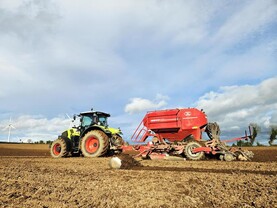

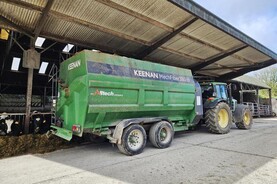
SHARING OPTIONS: